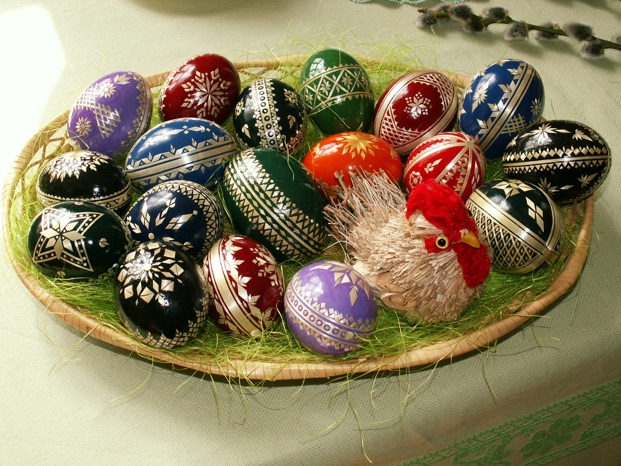Slavic Easter Egg
Links
Slavic Easter Egg
Links


The tradition of egg decoration in Slavic cultures originated in pagan times, and was transformed by the process of religious syncretism into the Christian Easter egg. Nevertheless, these decorated eggs have retained much of their pagan symbolism.
Many Slavic ethnic groups, including the Bulgarians (писано яйце, pisano yaytse), Croats (pisanica), Czechs (kraslice), Poles (pisanka), Serbs (писаница, pisanica), Slovaks (kraslica), Sorbs, Slovenes (pisanica or pirh), and Ukrainians (писанка, pysanka), decorate eggs for Easter. Many of the names derive from the Slavic root pisa which relates to writing. In Slavic tradition, the egg (similar to icons) is written, not drawn or painted.
Some non-slavic eastern Europeans also decorate eggs (wax resist) for Easter. Particularly nice ones are created by the Lithuanians (margučiai) and Romanians.
The pattern is usually applied to an egg by the process of wax-resist, similar to batik. A stylus is used to apply hot wax to the shell of an egg, which is placed in a series of dye baths. The wax seals the dye into the egg; the colors and pattern are revealed when the wax is removed (by melting it off) at the end.
Other techniques include "drop-pull" eggs, a variation on batik which uses a simple pin head to apply wax; a "scratch" technique, where dye is applied to an egg and then patterns scratched onto the shell; painted eggs, where the shells are painted using a brush; and various versions of appliqué, where items (straw, paper, beads, sequins) are glued to the shell of an egg.
While decorated eggs of various Slavic nations have much in common, national traditions vary. On these sites you can look at some nice examples:
There are lots of Sorbian eggs on line nowadays. A good place to look for them is on Pinterest, with a simple search.
There also used to be a huge gallery of Romanian eggs, with hundreds of photos, but it, too, has disappeared. I found a Flickr photostream that shows how to make “Pace eggs” (above). There is a Romanian eggs group on Flickr, but many of the photos are of very non-traditional eggs. I have also found many isolated images (via Google), like this, this or this. But there are no nice Romanian sites at the moment. Pinterest, once again, will provide you lots of photos.
Strangely, I cannot find a decent Polish site. There are many sites with lots of photos of Polish eggs, but they are all malyowanki (painted) and not true pisanki (wax-resist). If you find any, let me know. There used to be a brilliant site called Eggstrart, but it now seems defunct. That artist made the most amazing drop-pull eggs based on her Polish heritage. She has moved to Etsy, and sells her work there, but there aren’t as many photos to look at.
As always, Google and Flickr have large collections of photos of decorated eggs, and there are, on Flickr, groups dedicated to Polish, Romanian and other types of eggs. While the photos are nice to look at, the majority are either non-traditional or misclassified, and there is little educational information provided. Pinterest has the same limitations–categorization is done by non-experts, and much of the material is misclassified. Still, all are worth a look.
Do check out my Pinterest page, where I’ve pinned photos of Eastern European Easter eggs from many different countries. I’ve had an ethnographer friend go through the photos and properly classify their country of origin, as well assessing how traditional they really are.

Hanácké kraslice, Easter eggs from the Haná region in the Czech Republic
Back to MAIN Pysanka home page.
Back to Main Links home page.
Back to Pysanka Index.
Search my site with Google
Other Decorated Slavic Eggs
Traditional Easter eggs in Croatia (Pisanica)